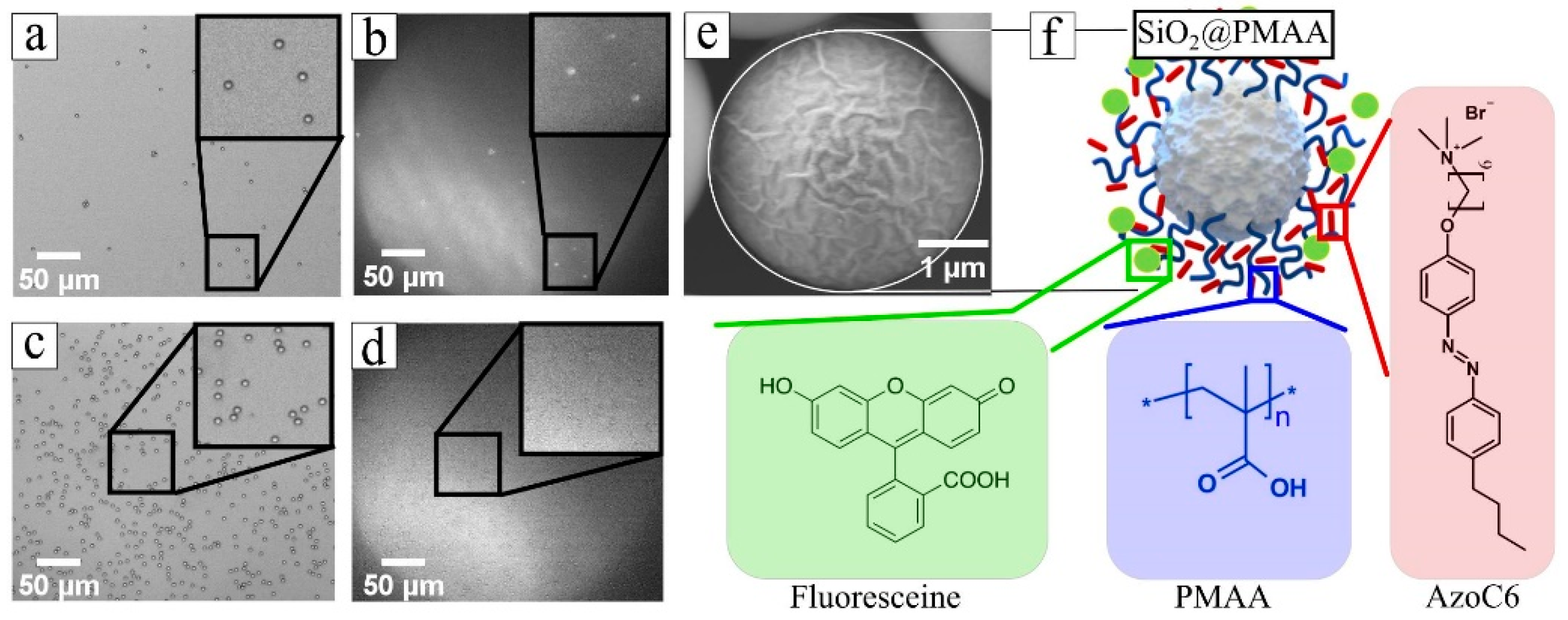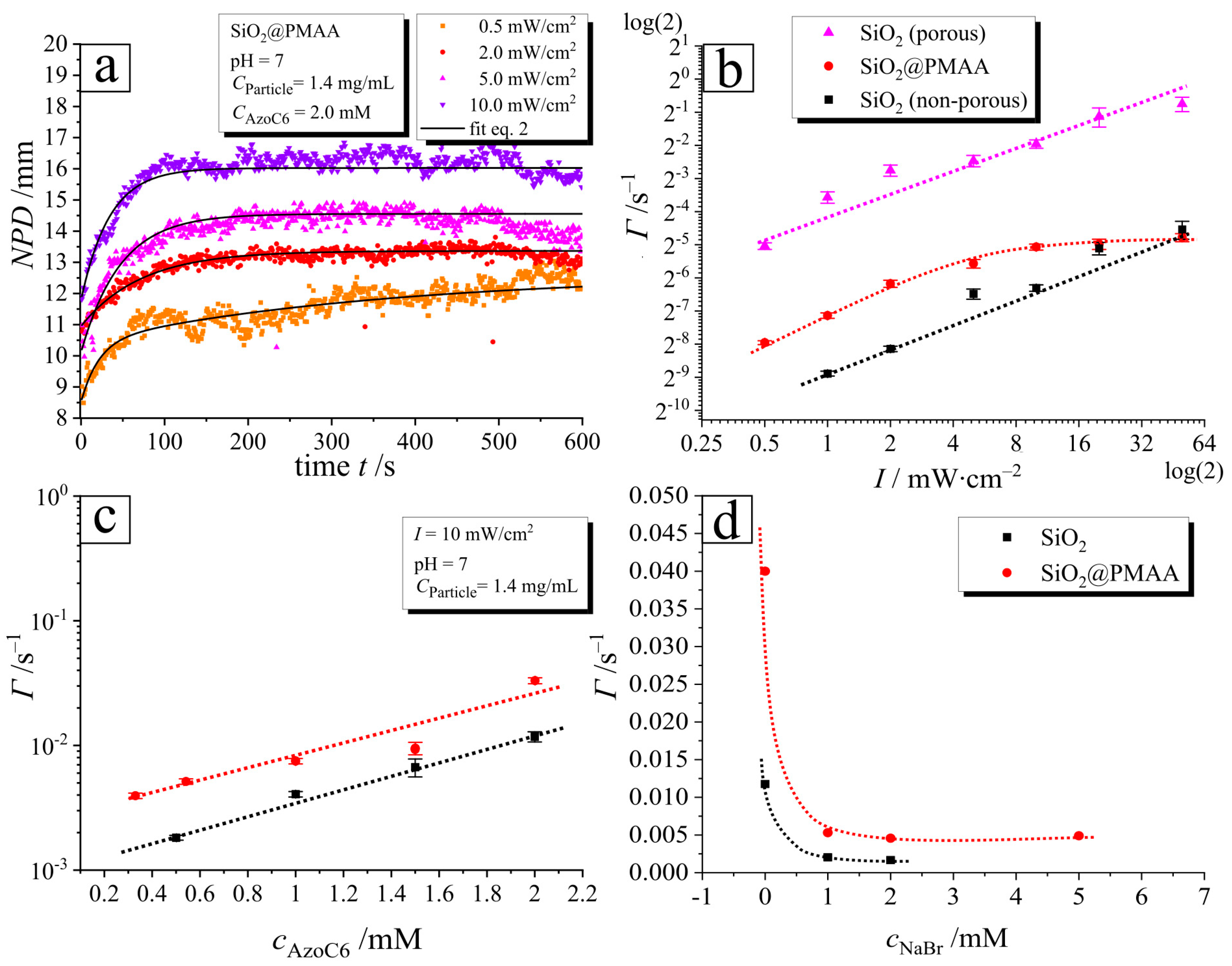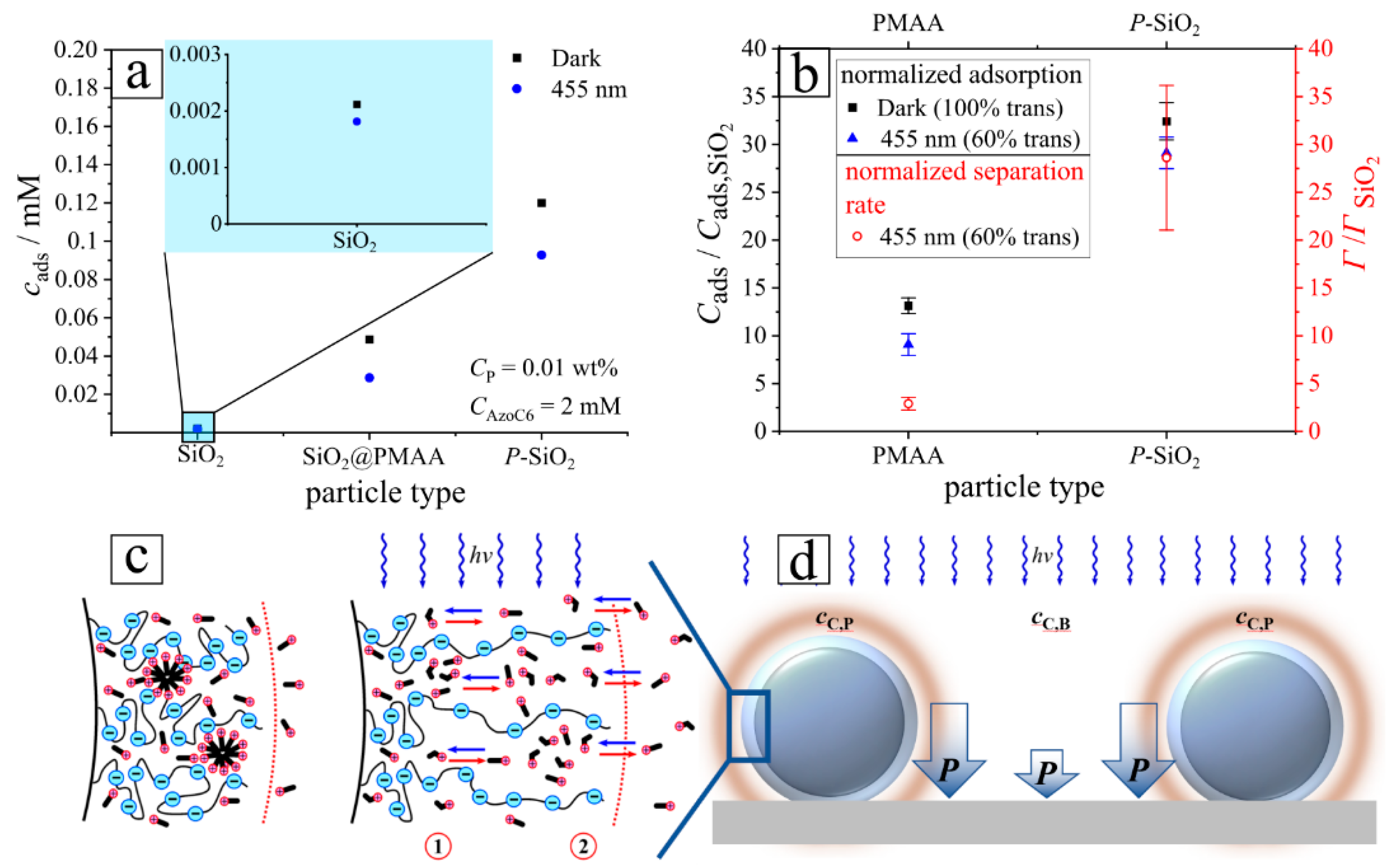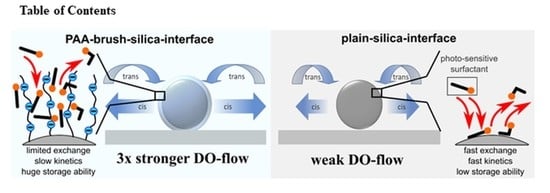Photosensitive Spherical Polymer Brushes: Light-Triggered Process of Particle Repulsion
Abstract
1. Introduction
2. Experimental Part
3. Results and Discussion
4. Conclusions
Supplementary Materials
Author Contributions
Funding
Data Availability Statement
Conflicts of Interest
References
- Ballauff, M. Spherical polyelectrolyte brushes. Prog. Polym. Sci. 2007, 32, 1135. [Google Scholar] [CrossRef]
- Ballauff, M.; Borisov, O. Polyelectrolyte brushes. Curr. Opin. Colloid Interface Sci. 2006, 11, 316–323. [Google Scholar] [CrossRef]
- Guo, X.; Weiss, A.; Ballauff, M. Synthesis of spherical poly-electrolyte brushes by photoemulsion polymerization. Macromolecules 1999, 32, 6043–6046. [Google Scholar] [CrossRef]
- Guo, X.; Ballauff, M. Spatial dimensions of colloidal polyelectrolytebrushes as determined by dynamic light scattering. Langmuir 2000, 16, 8719–8726. [Google Scholar] [CrossRef]
- Schrinner, M.; Haupt, B.; Wittemann, A. A novel photoreactor for theproduction of electrosterically stabilised colloidal particles at largerscales. Chem. Eng. J. 2008, 144, 138–145. [Google Scholar] [CrossRef]
- Hoffmann, M.; Yan, L.; Schrinner, M.; Ballauff, M.; Harnau, L. Dumbbell-shaped polyelectrolyte brushes studied by depo-larized dynamiclight scattering. J. Phys. Chem. B 2008, 112, 14843–14850. [Google Scholar] [CrossRef]
- Wang, X.; Xu, J.; Li, L.; Wu, S.; Chen, Q.; Lu, Y.; Ballauff, M.; Guo, X. Synthesis of spherical polyelectrolyte brushes by ther-mo-controlled emulsion polymerization. Macromol. Rapid Commun. 2010, 31, 1272–1275. [Google Scholar] [CrossRef] [PubMed]
- Hui, C.M.; Pietrasik, J.; Schmitt, M.; Mahoney, C.; Choi, J.; Bockstaller, M.R.; Matyjaszewski, K. Surface-initiated polymeriza-tion as an enabling tool for multifunctional (nano-)engineered hybrid materials. Chem. Mater. 2014, 26, 745–762. [Google Scholar] [CrossRef]
- Zhang, M.; Liu, L.; Zhao, H.; Yang, Y.; Fu, G.; He, B. Double-responsive polymer brushes on the surface of colloid particles. J. Colloid Interface Sci. 2006, 301, 85–91. [Google Scholar] [CrossRef]
- Polzer, F.; Heigl, J.; Schneider, C.; Ballauff, M.; Borisov, O.V. Synthesis and analysis of zwitterionic spherical polyelectrolyte brushes in aqueous solution. Macromolecules 2011, 44, 1654–1660. [Google Scholar] [CrossRef]
- Pfaff, A.; Shinde, V.S.; Lu, Y.; Wittemann, A.; Ballauff, M.; Müller, A.H.E. Glycopolymer-grafted polystyrene nanospheres. Macromol. Biosci. 2011, 11, 199–210. [Google Scholar] [CrossRef] [PubMed]
- Jusufi, A.; Likos, C.N.; Ballauff, M. Counterion distributions and effective interactions of spherical polyelectrolyte brushes. Colloid Polym. Sci. 2004, 282, 910–917. [Google Scholar] [CrossRef]
- Wittemann, A.; Drechsler, M.; Talmon, Y.; Ballauff, M. High elongation of polyelectrolyte chains in the osmotic limit of spherical poly-electrolyte brushes: A study by cryogenic transmission electron microscopy. J. Am. Chem. Soc. 2005, 127, 9688–9689. [Google Scholar] [CrossRef]
- Das, B.; Guo, X.; Ballauff, M. The osmotic coefficient of spherical polyelectrolyte brushes in aqueous salt-free solution. Prog. Colloid Polym. Sci. 2002, 121, 34–38. [Google Scholar]
- Christau, S.; Thurandt, S.; Yenice, Z.; von Klitzing, R. Stimuli-responsive polyelectrolyte brushes as a matrix for the attachment of gold nanoparticles: The effect of brush thickness on particle distribution. Polymers 2014, 6, 1877. [Google Scholar] [CrossRef]
- Kesal, D.; Christau, S.; Krause, P.; Möller, T.; von Klitzing, R. Uptake of pH-sensitive gold nanoparticles in strong polyelec-trolyte brushes. Polymers 2016, 8, 134. [Google Scholar] [CrossRef]
- Cao, Q.; Zuo, C.; Li, L. Electrostatic binding of oppositely charged surfactants to spherical polyelectrolyte brushes. Phys. Chem. Chem. Phys. 2011, 13, 9706–9715. [Google Scholar] [CrossRef]
- Riley, J.K.; An, J.; Tilton, R.D. Ionic Surfactant Binding to pH-Responsive Polyelectrolyte Brush-Grafted Nanoparticles in Suspension and on Charged Surfaces. Langmuir 2015, 31, 13680–13689. [Google Scholar] [CrossRef]
- Lu, Y.; Ballauff, M. Spherical polyelectrolyte brushes as nanoreactors for the generation of metallic and oxidic nanoparticles: Synthesis and application in catalysis. Prog. Polym. Sci. 2016, 59, 86–104. [Google Scholar] [CrossRef]
- Samokhina, L.; Schrinner, M.; Ballauff, M.; Drechsler, M. Binding of Oppositely Charged Surfactants to Spherical Polyelec-trolyte Brushes: A Study by Cryogenic Transmission Electron Microscopy. Langmuir 2007, 23, 3615–3619. [Google Scholar] [CrossRef]
- Walkowiak, J.; Lu, Y.; Gradzielski, M.; Zauscher, S.; Ballauff, M. Thermodynamic Analysis of the Uptake of a Protein in a Spherical Polyelectrolyte Brush. Macromol. Rapid Commun. 2020, 41, 1900421. [Google Scholar] [CrossRef] [PubMed]
- Gu, S.; Risse, S.; Lu, Y.; Ballauff, M. Mechanism of the Oxidation of 3,3′,5,5′-Tetramethylbenzidine Catalyzed by Peroxi-Dase-Like Pt Nanoparticles Immobilized in Spherical Polyelectrolyte Brushes: A Kinetic Study. ChemPhysChem 2020, 21, 450–458. [Google Scholar] [CrossRef] [PubMed]
- Li, L.; Li, M.; Qiu, Z.; Chen, K.; Xu, Y.; Guo, X.; Wang, J. Catalytic Activity Comparison of Gold Nanoparticles in Annealed and Quenched Spherical Polyelectrolyte Brushes. Chem. Lett. 2022, 51, 284–287. [Google Scholar] [CrossRef]
- Sun, L.; Fu, Z.; Ma, E.; Guo, J.; Zhang, Z.; Li, W.; Li, L.; Liu, Z.; Guo, X. Ultra small Pt Nanozymes Immobilized on Spherical Polyelectrolyte Brushes with Robust Peroxidase-like Activity for Highly Sensitive Detection of Cysteine. Langmuir 2022, 38, 12915–12923. [Google Scholar] [CrossRef]
- Yaroslavov, A.A.; Sybachin, A.V.; Zaborova, O.V.; Migulin, V.A.; Samoshin, V.V.; Ballauff, M.; Kesselman, E.; Schmidt, J.; Talmon, Y.; Menger, F.M. Capacious and programmable multi-liposomal carriers. Nanoscale 2015, 7, 1635–1641. [Google Scholar] [CrossRef] [PubMed]
- Wittemann, A.; Haupt, B.; Ballauff, M. Adsorption of proteins on spher-ical polyelectrolyte brushes in aqueous solution. Phys. Chem. Chem. Phys. 2003, 5, 1671–1677. [Google Scholar] [CrossRef]
- Haupt, B.; Neumann, T.; Wittemann, A.; Ballauff, M. Activity of enzymes immobilized in colloidal spherical polyelectrolyte brushes. Biomacromolecules 2005, 6, 948–955. [Google Scholar] [CrossRef]
- Henzler, K.; Haupt, B.; Lauterbach, K.; Wittemann, A.; Borisov, O.; Ballauff, M. Adsorption of actoglobulin on spherical polyelectrolyte brushes: Direct proof of counterion release by isothermal titration calorimetry. J. Am. Chem. Soc. 2010, 132, 3159–3163. [Google Scholar] [CrossRef]
- Rumyantsev, A.M.; Santer, S.; Kramarenko, E.Y. Theory of Collapse and Overcharging of a Polyelectrolyte Microgel Induced by an Oppositely Charged Surfactant. Macromolecules 2014, 47, 5388–5399. [Google Scholar] [CrossRef]
- Sun, L.; Han, H.; Liu, Z.; Fu, Z.; Hua, C.; Ma, E.; Guo, J.; Liu, J.; Li, L.; Fang, B.; et al. Immobilization of Gold Nanoparticles in Spherical Polymer Brushes Observed by Small-Angle X-ray Scattering. Langmuir 2022, 38, 1869–1876. [Google Scholar] [CrossRef]
- Mei, Y.; Lauterbach, K.; Hoffmann, M.; Borisov, O.V.; Ballauff, M.; Jusufi, A. Collapse of Spherical Polyelectrolyte Brushes in the Presence of Multivalent Counterions. Phys. Rev. Lett. 2006, 97, 158301. [Google Scholar] [CrossRef]
- Konradi, R.; Rühe, J. Binding of oppositely charged surfactants to poly (methacrylic acid) brushes. Macromolecules 2005, 38, 6140. [Google Scholar] [CrossRef]
- Iqbal, D.; Yan, J.; Matyjaszewski, K.; Tilton, R.D. Swelling of multi-responsive spherical polyelectrolyte brushes across a wide range of grafting densities. Colloid Polym. Sci. 2020, 298, 35–49. [Google Scholar] [CrossRef]
- Sin, J.S.; Choe, I.-C.; Im, C.-S. Electric double layer of spherical pH-responsive polyelectrolyte brushes in an electrolyte solution: A strong stretching theory accounting for excluded volume interaction and mass action law. Phys. Fluids 2022, 34, 097121. [Google Scholar] [CrossRef]
- Rühe, J.; Ballauff, M.; Biesalski, M.; Dziezok, P.; Gröhn, F.; Johannsmann, D.; Houbenov, N.; Hugenberg, N.; Konradi, R.; Minko, S.; et al. Polyelectrolyte brushes. Adv. Comput. Simul. Approaches Soft Matter Sci. I 2004, 165, 79–150. [Google Scholar]
- Li, M.; Zhuang, B.; Yu, J. Effects of Ion Valency on Polyelectrolyte Brushes: A Unified Theory. Macromolecules 2022, 55, 10450–10456. [Google Scholar] [CrossRef]
- Guo, X.; Ballauff, M. Spherical polyelectrolyte brushes: Comparison between annealed and quenched brushes. Phys. Rev. E 2001, 64, 051406. [Google Scholar] [CrossRef]
- Mei, Y.; Ballauff, M. Effect of counterions on the swelling of spherical polyelectrolyte brushes. Eur. Phys. J. E 2005, 16, 341–349. [Google Scholar] [CrossRef] [PubMed]
- Quan, G.; Wang, M.; Tong, C. A numerical study of spherical polyelectrolyte brushes by the self-consistent field theory. Polymer 2014, 55, 6604–6613. [Google Scholar] [CrossRef]
- Feldmann, D.; Arya, P.; Molotilin, T.Y.; Lomadze, N.; Kopyshev, A.; Vinogradova, O.I.; Santer, S. Extremely Long-Range Light-Driven Repulsion of Porous Microparticles. Langmuir 2020, 36, 6994. [Google Scholar] [CrossRef]
- Arya, P.; Jelken, J.; Lomadze, N.; Santer, S.; Bekir, M. Kinetics of photo-isomerization of azobenzene containing surfactants. J. Chem. Phys. 2020, 152, 024904. [Google Scholar] [CrossRef] [PubMed]
- Montagna, M.; Guskova, O. Photosensitive Cationic Azobenzene Surfactants: Thermodynamics of Hydration and the Complex Formation with Poly(methacrylic acid). Langmuir 2018, 34, 311. [Google Scholar] [CrossRef] [PubMed]
- Arya, P.; Jelken, J.; Feldmann, D.; Lomadze, N.; Santer, S. Light driven diffusioosmotic repulsion and attraction of colloidal particles. J. Chem. Phys. 2020, 152, 194703. [Google Scholar] [CrossRef]
- Sharma, A.; Bekir, M.; Lomadze, N.; Jung, S.-H.; Pich, A.; Santer, S. Generation of Local Diffusioosmotic Flow by Light Re-sponsive Microgels. Langmuir 2022, 38, 6343–6351. [Google Scholar] [CrossRef]
- Jelken, J.; Jung, S.H.; Lomadze, N.; Gordievskaya, Y.D.; Kramarenko, E.Y. Tuning the Volume Phase Transition Temperature of Microgels by Light. Adv. Funct. Mater. 2022, 32, 2107946. [Google Scholar] [CrossRef]
- Kopyshev, A.; Galvin, C.J.; Patil, R.R.; Genzer, J.; Lomadze, N.; Feldmann, D. Light-induced reversible change of roughness and thickness of photosensitive polymer brushes. ACS Appl. Mater. Interfaces 2016, 8, 19175–19184. [Google Scholar] [CrossRef]
- Kopyshev, A.; Lomadze, N.; Feldmann, D.; Genzer, J.; Santer, S. Making polymer brush photosensitive with azobenzene containing surfactants. Polymer 2015, 79, 65–72. [Google Scholar] [CrossRef]
- Zakrevskyy, Y.; Cywinski, P.; Cywinska, M.; Paasche, J.; Lomadze, N.; Reich, O.; Löhmannsröben, H.-G.; Santer, S. Interaction of photosensitive surfactant with DNA and poly acrylic acid. J. Chem. Phys. 2014, 140, 044907. [Google Scholar] [CrossRef]
- Sharma, A.; Bekir, M.; Lomadze, N.; Santer, S. Photo-Isomerization Kinetics of Azobenzene Containing Surfactant Conjugated with Polyelectrolyte. Molecules 2021, 26, 19. [Google Scholar] [CrossRef]
- Umlandt, M.; Feldmann, D.; Schneck, E.; Santer, S.; Bekir, M. Adsorption of Photoresponsive Surfactants at Solid−Liquid In-terface. Langmuir 2020, 36, 14009. [Google Scholar] [CrossRef]
- Bekir, M.; Sharma, A.; Umlandt, M.; Lomadze, N.; Santer, S. How to turn any surface to act as a micropump. Adv. Mater. Interf. 2022, 9, 2102395. [Google Scholar] [CrossRef]
- Feldmann, D.; Maduar, S.R.; Santer, M.; Lomadze, N.; Vinogradova, O.I.; Santer, S. Manipulation of small particles at solid liquid interface: Light driven diffusioosmosis. Sci. Rep. 2016, 6, 36443. [Google Scholar] [CrossRef] [PubMed]
- Frenkel, M.; Arya, P.; Bormachenko, E.; Santer, S. Quantification of Ordering in Active Light Driven Colloids. J. Colloid Interface Sci. 2021, 586, 866–875. [Google Scholar] [CrossRef]
- Sokolowski, M.; Bartsch, C.; Spiering, V.J.; Prévost, S.; Appavou, M.-S.; Schweins, R.; Gradzielski, M. Preparation of Polymer Brush Grafted Anionic or Cationic Silica Nanoparticles: Systematic Variation of the Polymer Shell. Macromolecules 2018, 51, 6936. [Google Scholar] [CrossRef]
- Sbalzarini, I.F.; Koumoutsakos, P. Feature point tracking and trajectory analysis for video imaging in cell biology. J. Struc. Biol. 2005, 151, 182–195. [Google Scholar] [CrossRef]
- Patil, R.R.; Turgman-Cohen, S.; Šrogl, J.; Kiserow, D.; Genzer, J. On-demand degrafting and the study of molecular weight and grafting density of poly(methyl methacrylate) brushes on flat silica substrates. Langmuir 2015, 31, 2372–2381. [Google Scholar] [CrossRef] [PubMed]
- Schimka, S.; Gordievskaya, Y.D.; Lomadze, N.; Lehmann, M.; Klitzing, R.; Rumyantsev, A.M.; Kramarenko, E.; Santer, S. Light driven remote control of microgels’ size in the presence of photosensitive surfactant: Complete phase diagram. J. Chem. Phys. 2017, 147, 031101. [Google Scholar] [CrossRef] [PubMed]
- Sharma, A.; Jung, S.-H.; Lomadze, N.; Pich, A.; Santer, S.; Bekir, M. Adsorption Kinetics of a Photosensitive Surfactant Inside Microgels. Macromolecules 2021, 54, 10682–10690. [Google Scholar] [CrossRef]
- Titov, E.; Sharma, A.; Lomadze, N.; Saalfrank, P.; Santer, S.; Bekir, M. Photoisomerization of Azobenzene-Containing Sur-factant within a Micelle. ChemPhotoChem 2021, 5, 926. [Google Scholar] [CrossRef]
- Prieve, D.C.; Anderson, J.L.; Ebel, J.P.; Lowell, M.E. Motion of a particle generated by chemical gradients. Part 2. Electrolytes. J. Fluid Mech. 1984, 148, 247–269. [Google Scholar] [CrossRef]
- Masalov, V.M.; Sukhinina, N.S.; Kudrenko, E.A.; Emelchenko, G.A. Mechanism of formation and nanostructure of Stöober silica particles. Nanotechnology 2011, 22, 275718. [Google Scholar] [CrossRef] [PubMed]




Disclaimer/Publisher’s Note: The statements, opinions and data contained in all publications are solely those of the individual author(s) and contributor(s) and not of MDPI and/or the editor(s). MDPI and/or the editor(s) disclaim responsibility for any injury to people or property resulting from any ideas, methods, instructions or products referred to in the content. |
© 2023 by the authors. Licensee MDPI, Basel, Switzerland. This article is an open access article distributed under the terms and conditions of the Creative Commons Attribution (CC BY) license (https://creativecommons.org/licenses/by/4.0/).
Share and Cite
Bekir, M.; Loebner, S.; Kopyshev, A.; Lomadze, N.; Santer, S. Photosensitive Spherical Polymer Brushes: Light-Triggered Process of Particle Repulsion. Processes 2023, 11, 773. https://doi.org/10.3390/pr11030773
Bekir M, Loebner S, Kopyshev A, Lomadze N, Santer S. Photosensitive Spherical Polymer Brushes: Light-Triggered Process of Particle Repulsion. Processes. 2023; 11(3):773. https://doi.org/10.3390/pr11030773
Chicago/Turabian StyleBekir, Marek, Sarah Loebner, Alexej Kopyshev, Nino Lomadze, and Svetlana Santer. 2023. "Photosensitive Spherical Polymer Brushes: Light-Triggered Process of Particle Repulsion" Processes 11, no. 3: 773. https://doi.org/10.3390/pr11030773
APA StyleBekir, M., Loebner, S., Kopyshev, A., Lomadze, N., & Santer, S. (2023). Photosensitive Spherical Polymer Brushes: Light-Triggered Process of Particle Repulsion. Processes, 11(3), 773. https://doi.org/10.3390/pr11030773






